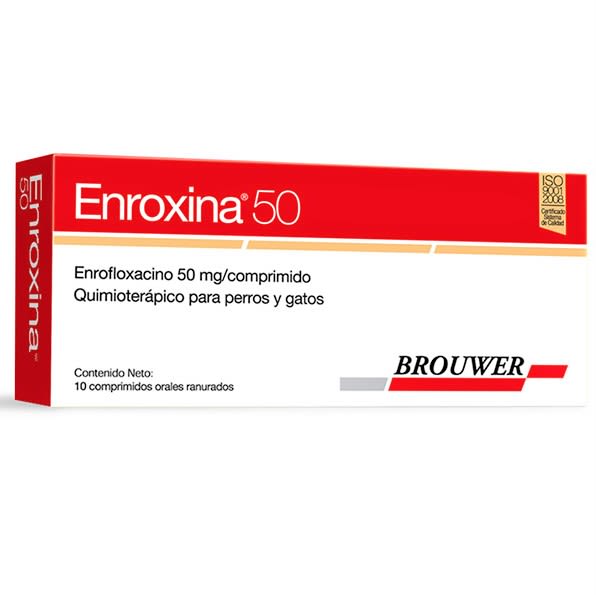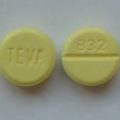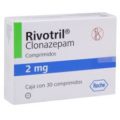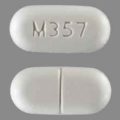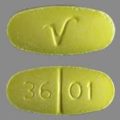Enroxina is a brand of enrofloxacin a broad-spectrum antibiotic used in veterinary medicine to treat animals afflicted with certain bacterial infections. This drug belongs to a class of antibiotics known as fluoroquinolones and is not an appropriate treatment option against infections caused by viruses, fungi, or parasites.
Enroxina is produced by Brouwer and is indicated for the treatment of infections involving Pseudomonas aeruginosa, Klebsiella, E.coli., Enterobacter, Campylobacter, Shigella, Salmonella, Aeromonas, Haemophilus, Proteus, Yersinia, Serratia, Vibrio, Brucella, Chlamydia, Staphylococci (including some methicillin-resistant strains), Mycoplasma, and Mycobacterium. Enroxina comes in 50mg, 100mg and 150mg.
How Does Enroxina Work?
Enroxina works by inhibiting the process of DNA synthesis within the bacterial cells, which results in cell death. This drug is commonly used to treat a range of bacterial infections, including those of the skin, urinary tract, and respiratory system, as well as infections that result from wounds.
It is not effective against anaerobic bacteria and can be variably effective against Streptococcus infections. Enroxina has a similar spectrum of activity as ciprofloxacin but Enroxina has been shown to have better bioavailability. Except for cerebral spinal fluid, Enroxina attains therapeutic levels in most tissues of the body. This makes it a very attractive antibiotic choice for difficult-to-treat infections, particularly those that need long-term antibiotics. Some examples might be osteomyelitis, sinus infections, otitis, difficult soft tissue infections, peritonitis, and pleuritis, or pneumonia.
Potential Side-Effects of Enroxina
This medication can cause some animal patients to experience certain side effects, generally diarrhea or loose stools. On very rare occasions, an animal can experience a seizure, while younger animals can experience swollen joints, general lethargy, and in some cases, cartilage damage when dosed above the recommended range and below the recommended age.
Drug Interactions with Enroxina
Enroxina can interact with one or more medications. Common culprits include iron supplements, antacids, and stomach protectants. Avoid giving with dairy products (such as cheese, cream cheese, or yogurt) because the calcium can bind to the drug, limiting its effectiveness. SEE: Can You Use Fish Antibiotics On Dogs
Precautions for Using Enroxina
Enroxina is appropriate for use in veterinary medicine. However, it should not be administered to puppies aged 28 weeks or younger. It should be used with caution in veterinary patients prone to seizures. Doses also need to be adjusted for patients with severe kidney or liver impairment. This medication should not be administered to an animal with a known allergy or hypersensitivity to it or other medications in the same class (marbofloxacin, ciprofloxacin, etc.)
Hydration should be monitored and fluid therapy used in animals at risk for dehydration. Enroxina should not be used for regional antibiotic perfusion because it is too irritating and can cause vasculitis. Enroxina is eliminated by both renal and hepatic metabolism.
Dosage and Administration of Enroxina
- Administer a daily dose of 5 mg/kg (corresponding to 1 tablet every 10 kg of body weight) in dogs and cats.
- This dose should be repeated every 24 hours.
- The multi-dose tablet allows for easy administration even in animals of low weight.
- The treatment should last from 5 to 10 days depending on the affected organ, the severity of the case and
- One of the positive features of Enroxina is that it is absorbed well orally and, in many cases, can be given once per day.
Fluoroquinolones including Enroxina have been shown to cause articular cartilage abnormalities when the drug is given at high dose levels. The age and breed of the patient should be considered when using Enroxina. Large and giant breeds can be more at risk because of a longer period of growth. Enroxina has been shown to be appropriate in pregnant and lactating dogs; however, because of the problems with articular cartilage, it should be avoided unless the benefits clearly outweigh the risks to the puppies. This work has not been repeated in cats.
Enroxina is well-absorbed orally and intravenously. It generally is not used intramuscularly because it is too irritating. Although studies have not been done on the horse, there is the risk of developmental cartilage abnormalities with the Fluoroquinolones antibiotics. Since horses are expected to be athletes, using Enroxina in the young horse should be weighed carefully against the potential risk of cartilage abnormality.

